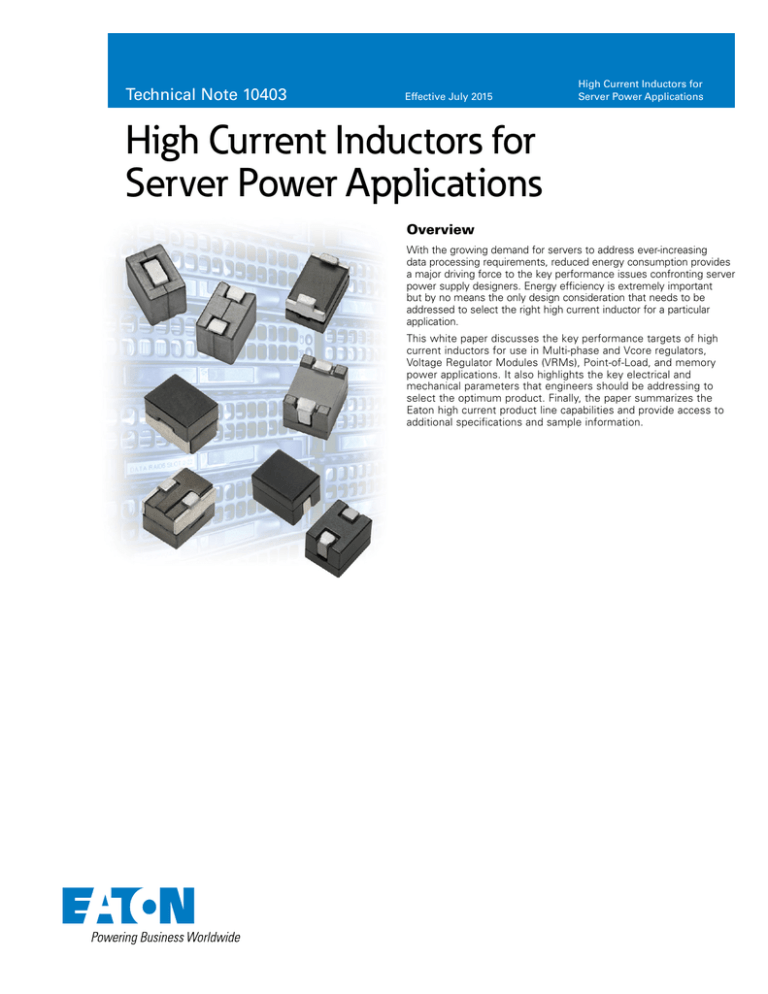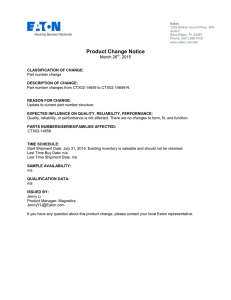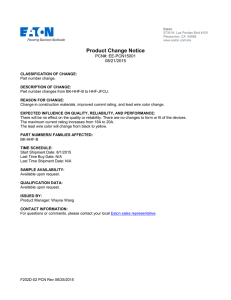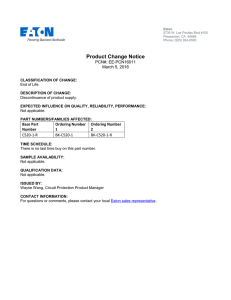
Technical Note 10403
Effective July 2015
High Current Inductors for
Server Power Applications
High Current Inductors for
Server Power Applications
Overview
With the growing demand for servers to address ever-increasing
data processing requirements, reduced energy consumption provides
a major driving force to the key performance issues confronting server
power supply designers. Energy efficiency is extremely important
but by no means the only design consideration that needs to be
addressed to select the right high current inductor for a particular
application.
This white paper discusses the key performance targets of high
current inductors for use in Multi-phase and Vcore regulators,
Voltage Regulator Modules (VRMs), Point-of-Load, and memory
power applications. It also highlights the key electrical and
mechanical parameters that engineers should be addressing to
select the optimum product. Finally, the paper summarizes the
Eaton high current product line capabilities and provide access to
additional specifications and sample information.
Technical Note 10403
Effective July 2015
High Current Inductors for Server Power Applications
Today’s Server Power Supply Challenges
Core Selection and Product Tradeoffs
With efficiency requirements dictated by regulations from governments around the world as well as the need to reduce the carbon
footprint of their products, server power supply designers are under
extreme pressure to maximize the highest efficiency possible.
Improving efficiency and reducing power losses in server power systems are also required for strictly competitive reasons.
For high current, the two most common inductor core materials are
ferrite and powder. Selection of the best core material occurs based
on inductance, tolerance of the inductance, current rating, saturation
current, shielded or non-shielded, DCR, Q at certain frequencies,
self-resonant frequency, operating temperature, mounting type and
package dimensions required for the application. It should be noted
that both electrical and physical attributes are important in this selection process.
The high current inductor is among the components that can deliver
improved efficiency once the design is optimized. In addition to the
higher current, higher operating temperature and higher frequency
requirements needed to obtain higher efficiency other important
selection criteria for power inductors include:
• Smaller size - reduces circuit layout area
• Tighter tolerances - assures consistent circuit performance
• Very low DC Resistance (DCR) - increases power efficiency
•M
ulti-phase Integration - reduces PCB footprint and
component count
Background and Definition of Terms
Eaton’s Electronics Division is a leading supplier of high current
and other inductors for DC-DC power conversion and switch-mode
power supply applications requiring high frequency operation. Eaton
designs and develops inductor products to achieve high efficiency
using high frequency ferrite material to satisfy light load and full load
efficiency requirements for VR12.5 and VR13 applications. Eaton’s
products designed specifically for these applications are widely used
in several IC reference designs.
Key parameters for assessing an inductor’s performance include:
• DC resistance (DCR)
• Open circuit inductance (OCL)
• Full load inductance (FLL)
Understanding application trade-offs is key to device selection
and hence material selection for inductor designers. Powder core
devices exhibit better temperature stability and Bsat. So, in some
cases for higher power density, a powder core may be preferred but
this choice sacrifices efficiency. Ferrite is the most efficient material
used in high power inductors. High efficiency inductors are made
by developing inductor core materials that produce high saturation
flux density with low core loss for operation from 300 kHz to 1.0
MHz and higher. However, higher current operation requires higher
saturation flux density (Bsat) materials. Higher ripple current and
frequencies result in higher core losses. Eaton’s inductor designers
understand these materials and performance trade-offs well to
maximize overall device performance.
Ferrite advantages in Server Power applications, compared with
powder core, are: 1) Higher operating frequency (3MHz now, up to
10MHz coming); 2) Much lower core loss for a given frequency and
AC flux density resulting in higher efficiency; and 3) Higher initial
permeability (Ui), up to 3300 (10-20 times powder material), to
achieve higher OCL.
An important comparison that system designers find on a specific
data sheet is the change in core loss versus increasing Bp-p. In Figure
1, core losses increase with increasing Bp-p and with increasing
frequencies. As demonstrated in this example, as an inductor’s total
losses increase the devices temperature will also increase. Increasing
temperature also increases the DCR value.
• Peak saturation current (Isat) vs. temperature
Core Loss vs. Bp-p
• Heat effect current (Irms)
• AC resistance (ACR).
It should be clear from the foregoing, that optimizing the selection
of high-current inductors requires evaluation of a wide assortment
of physical and electrical variables. While all customers desire higher
efficiency and lower losses, all customer applications are not the
same. Thermal management, space constraints and other aspects
make the optimal choice of a power inductor a nontrivial task. At the
root of this process for Eaton’s inductor designers is the selection of
the core material.
Core Loss (W)
• K-factor used to determine Bp-p (in Gauss) for core loss
1
0.1
0.01
0.001
0.0001
100
1000
10000
Bp-p (Gauss)
Temperature rise (˚C)
• Magnetic saturation flux density, in Gauss (Bsat)
1MHz 500kHz
300kHz
200kHz
100kHz
10
50
40
30
20
10
0
0
0.2
0.4
0.6 0.8
1
1.2
1.4 1.6
Total Loss (W)
Figure 1. a ) Core loss vs Bp-p with increasing frequencies.
b) Temperature vs. total loss.
2
EATON www.eaton.com/elx
High Current Inductors for Server Power Applications
Technical Note 10403
Effective July 2015
Choosing the Eaton Solution
A Process of Collaboration
Eaton’s magnetics product line offers a wide selection of inductors
with different inductance and current values and advanced packaging to meet today’s demand for high current power supplies for the
server and memory industry. The success of these products is based
on the continuous investment and resulting outstanding capabilities of
design, manufacturing and test facilities within Eaton’s global group.
The facilities have a combination of certifications and recognitions
which include:
For Eaton, an application-specific approach allows the selection of
the right inductor for each application. This can involve modifying an
existing design to fit a customer’s needs. While this is not uncommon in the inductor business, the differentiation occurs with the
experience and expertise of the inductor supplier.
• ISO9001 (Quality System): A quality management system focused
on meeting customer expectations and delivering customer satisfaction with the purpose of giving attention to the customer.
•T
S16949 (Quality System): A quality management system focused
on meeting the specific and rigorous requirements of the automotive industry
• ISO17025 (Testing Facility): It is the single most important standard for calibration and testing laboratories around the world.
Laboratories that are accredited to this international standard have
demonstrated that they are technically competent and able to produce precise and accurate test and/or calibration data.
In addition to those products that have established Eaton’s product
line as an industry leader, our research and development efforts with
leading IC manufacturers and OEM system companies have created
new and exciting solutions to address industry trends and the need
for ever-increasing efficiency.
Reducing PCB Footprint
The electronics industry’s need for high efficiency and high power
density in a smaller area is driving inductor suppliers to reduce the
high current inductor’s form factor overall size. To meet this need,
factors that impact the inductor’s design include:
For new product design, or a simple derivative of an existing product, with the customer’s input regarding the application specifics
(including AC current, DC current, operating frequency, operating
temperature and more) and an interactive dialog, our design experts
select the appropriate product or core material to meet the application operating requirements. The interactive process with proposed
prototypes and testing in the customer’s circuit and modification, if
necessary, occurs until the highest efficiency/optimized solution is
achieved.
Knowing whether the core material and other design factors will
properly address a specific application is part of the expertise
derived from Eaton’s long history and breadth of products for highfrequency power supply applications.
Modeling
Simulation is one of the many tools employed by our design experts.
As shown in Figure 2, the modeling of the gap or bulk materials
identifies innovative approaches for advanced inductor designs to
solve the industry’s need for higher efficiency.
Device design
Model A
Two small gaps
Model B
Single large gap
Model C
Low µe 1 material gap
Model D
Ferrite distributed gap
material µe 2
• Higher switching frequency
Flux lines distribution
• Better core material
• Higher operating frequency
• Higher Bsat
• Lower core loss
• Wider operating temperature range
Eaton addresses the latest design criteria with several new inductors to allow designers achieve an optimum solution.
Addressing Tighter Tolerances
Although the inductor is rarely used in a current sense application,
tight DCR tolerance remains a desired product feature. Tighter DCR
and OCL tolerances provide designers with important benefits in
assuring circuit stability and consistent performance from lot-to-lot in
volume manufacturing. Achieving this level of precision is the result
of the combination of several factors:
• Consistent manufacturing processes
• Quality raw material for both core and winding
• Optimum design for manufacturing
• Precise testing system
Rac for different frequencies
Frequency
(Hz)
100k
500k
1M
Rac(Ω/m)
A
B
C
0.101 0.166 0.117
0.357 0.540 0.322
0.567 0.864 0.289
D
0.033
0.070
0.104
Figure 2. M
odeling is one of Eaton’s Electronics Division tools for providing higher
efficiency inductors.
Extensive Testing Capabilities
Mechanical and thermal shock, vibration, and solder reflow testing
are among the in-house capabilities that Eaton has specifically for
developing and qualifying new inductors and new inductor technologies. This test capability is possibly the most extensive in the inductor industry, with the highest ISO (ISO17025) qualifications.
All of these aspects are addressed in Eaton’s industry-leading
approach to high-power inductor design and manufacturing.
EATON www.eaton.com/elx
3
High Current Inductors for Server Power Applications
Technical Note 10403
Effective July 2015
Products to Meet Customer Requirements
One of Eaton’s most successful products is the Ferrite-based FlatPac series. Eaton has developed several Flat-Pac (FP) inductors to
address today’s server and memory power supply requirements.
The FP product line uses ferrite cores and offers a large selection of
space-saving package types with different inductance and current
values to meet OEM high power requirements. This section identifies the newest products, shows the packaging and device capabilities and discusses their role in helping customers optimize the
selection of the right product.
FP Dual Inducto
This dual-mode inductor offers manufacturers space saving and
reduced manufacturing costs. Several form factors are provided
in surface mount, both vertical and horizontal orientation, and in
through-hole. The dual design benefits include PCB area space saving and reduction in manufacturing cost by reducing pick-and-place
time. See Figure 3 for the offering overview.
40
Isat Current (A)
60
70
80
50
90
100
110
(a)
(b)
Figure 5. T
wo techniques to get more space under the inductor: (a) an elevated
leadform and (b) a deeper mold channel.
FP Open Bottom Inductor
Folding the leads under the inductor (Figure 5 (a)) increases the gap
from 0.2 to 0.3 mm. This initially allowed mounting the inductor over
traces on the PCB. The industry followed Eaton’s lead and adopted
this design approach. The deep mold channel (Figure 5 (b)) is another
innovative Eaton solution that achieves a gap of as much as 0.8 mm.
In addition to mounting the power stage under the inductor, which
is increasingly popular with point of load (POL) applications, other
options include a chip resistor or chip capacitor placed under the
inductor.
The actual space required for the cutout depends on the customer
application and Eaton has been able to modify this design for this
purpose. Figure 6 shows the capabilities of the industry’s newest
package.
Isat (A)
DCR (mΩ)
20
OCL (µH)
0.00 0.10
0.20 0.30 0.40 0.50
DCR (mΩ) and OCL (µH)
0.60
40
Isat Current (A)
60
80
100
120
Isat (A)
0.70
DCR (mΩ)
Figure 3. F
P Dual inductor provides designers options.
FP Small Size
OCL (µH)
Reducing the size of the inductor (item 1, above) to extremely
small (a few millimeters on each side) dimension is desired, even
as the saturation current per phase is increasing. This requirement
demands high flux density material with lower core loss at high frequencies.
To satisfy the industry’s requirement for smaller size, Eaton has
developed a ferrite-based series of 4 mm by 4-mm and 5 mm by
5-mm inductors with varying height. The small size allows designers
to include more content/new features on the PCB and the inductor’s
low fringing flux enables a high-density layout. The height ranges
from 3 mm to 6.6 mm. See Figure 4 for other product capabilities.
20
Isat Current (A)
40
60
80
100
Isat (A)
0.00
0.10
0.20
0.30
0.40
0.50
DCR (mΩ) and OCL (µH)
Figure 6. The innovative FP Bottom gap design allows running copper traces or
mounting a variety of components under the inductor to save PCB space.
FP Vertical
Increasing functionality typically requires increased power. Increasing
the number of phases is one approach to obtain more power
However, to fit in the same space, the inductor width has to be
between 6 to 7mm. Shown in Figure 7, Eaton’s solution is a narrowwidth inductor with increased height - the FP Vertical package. In initial products, the inductance ranges from 120 nH to 320 nH, current
ranges from 34A to 77A at 100°C and the height goes up to 14 mm.
These vertically orientated FP inductor designs provide the incremental power required with a form factor that reduces PCB area.
DCR (mΩ)
40
OCL (µH)
Isat Current (A)
60
80
100
Isat (A)
0.00
0.10
0.20
0.30
DCR (mΩ) and OCL (µH)
0.40
Figure 4. F
P Small size occupies as little as 4 mm by 4 mm of PCB space.
0.50
DCR (mΩ)
OCL (µH)
0.10
0.20
0.30
DCR (mΩ) and OCL (µH)
0.40
Figure 7. F
P Vertical packaging addresses the industry’s need for more power
while reducing the PCB space consumed.
4
EATON www.eaton.com/elx
High Current Inductors for Server Power Applications
Technical Note 10403
Effective July 2015
The Roadmap to Greater Efficiency
FP Low DCR
Eaton’s low DCR products address the need for improved efficiency.
These new inductor designs have a DCR as low as 0.125mΩ. With
an understanding of customer performance requirements, these low
DCR inductors provide another option to increase system efficiency
in a small package.
50
60
Isat Current (A)
70
80
90 100
110
120 130
Isat (A)
To address the increasing need for greater system efficiency, higher
power density and other current trends, Eaton’s inductor experts
have developed and released the aforementioned new products.
These new products are being rapidly adopted and becoming the
next generation of standard products in the marketplace.
Additional products that designers can expect to see in the near
future include: swing choke, hybrid ferrite with composite magnetic
materials, ultra-low DCR inductors, and more. While each addresses
a different design issue and many are covered by patents, these
inductors all target greater system efficiency in high-current power
applications.
DCR (mΩ)
Optimizing Your Inductor Selection
OCL (µH)
0.11 0.12 0.13 0.14 0.15 0.16 0.17 0.18 0.19
DCR (mΩ) and OCL (µH)
Figure 8. FP Low DCR design provides another solution for higher efficiency.
FP Ultra low DCR
Eaton’s new ultra low DCR Flat Pac products have been introduced
recently to improve the overall efficiency of the power stage. The
low DCR is achieved by adding extra copper on the side of the
inductor’s leads as illustrated in Figure 9. In current offerings, the
inductance ranges from 50 nH to 330 nH and current ranges from
152 to 20 Amps. The DCR of this product line can reach as low as
0.05 mΩ. This is the lowest DCR in this class of inductor and lowest
in the industry.
20
40
Isat Current (A)
60
80
100
Isat (A)
DCR (mΩ)
OCL (µH)
0.00
0.05
0.10
0.15
DCR (mΩ) and OCL (µH)
0.20
A major task for a system design engineer is system design validation. Device selection is an important part of this step and sometimes
system engineers will compare inductors from different manufacturers to determine which part to choose. Although comparison testing
is good engineering practice, it can lead to misleading results. This is
because each product family is designed and optimized for a targeted
application, i.e. operating frequency range, ripple current, and/or DC
current.
Each product family incorporates voice of the customer requirements
such as inductance versus DC current at different temperatures,
core loss at application conditions, DC resistance requirements, temperature rise versus total loss and estimated total loss at application
conditions. Typically there are performance trade-offs amongst these
requirements resulting in different products utilizing different materials and/or processes, each optimized for its application. Therefore,
comparing 150 µH parts of similar size from two different manufacturers, for example, may not result in the correct conclusion. At
Eaton, we strongly recommend discussing your application with our
Field Application Engineers and Internal Application and Design teams
to ensure you are selecting the best product for your application.
Satisfying the server power requirements for increased efficiency,
higher power and reduced footprint and other critical design parameters requires exceptional design and manufacturing expertise for
power inductor suppliers. In addition to the obvious design criteria of
AC current, DC current, frequency and temperature that drive core
material and other inductor design aspects, there are subtle applications issues that must be addressed. Many times system designers
are not fully aware of these issues and are not asked the right questions.
Based on the numerous times that Eaton has worked with unusual
design requirements, the iterative, interactive process used by
Eaton’s inductor experts brings out these design aspects to ensure
the proper, optimized application-specific inductor solution.
Figure 9. FP Ultra low DCR products provide the industry’s lowest DCR values.
EATON www.eaton.com/elx
5
High Current Inductors for Server Power Applications
Technical Note 10403
Effective July 2015
Please contact Eaton with your
design requirements.
Sales and Customer Service
Americas
Email: busselx@eaton.com
Phone: 561-998-4100
Europe, Middle East, Africa
Email: elx.emea@eaton.com
Phone: +34-93-736-2813
China
Email: elx.cn@eaton.com
Phone: +86 20 38391977 ext. 860
Taiwan
Email: elx.tw@eaton.com
Phone: +886 2 66006688 ext. 2794
Japan
Email: elx.jp@eaton.com
Phone: +86 20 38391977 ext. 864
Korea
Email: elx.kr@eaton.com
Phone: +82 2 6380 4831
South East Asia
Email: elx.sea@eaton.com
Phone: +65-6645 9816
Resources
Datasheets: www.eaton.com/elx-datasheets
Samples: www.eaton.com/elx-samples
Tech Support: InductorTech@eaton.com
FuseTech@eaton.com
CapacitorTech@eaton.com
Eaton
Electronics Division
1000 Eaton Boulevard
Cleveland, OH 44122
United States
www.eaton.com/elx
© 2015 Eaton
All Rights Reserved
Printed in USA
Publication No. 10403 — BU-MC15004
July 2015
Eaton is a registered trademark.
All other trademarks are property
of their respective owners.



